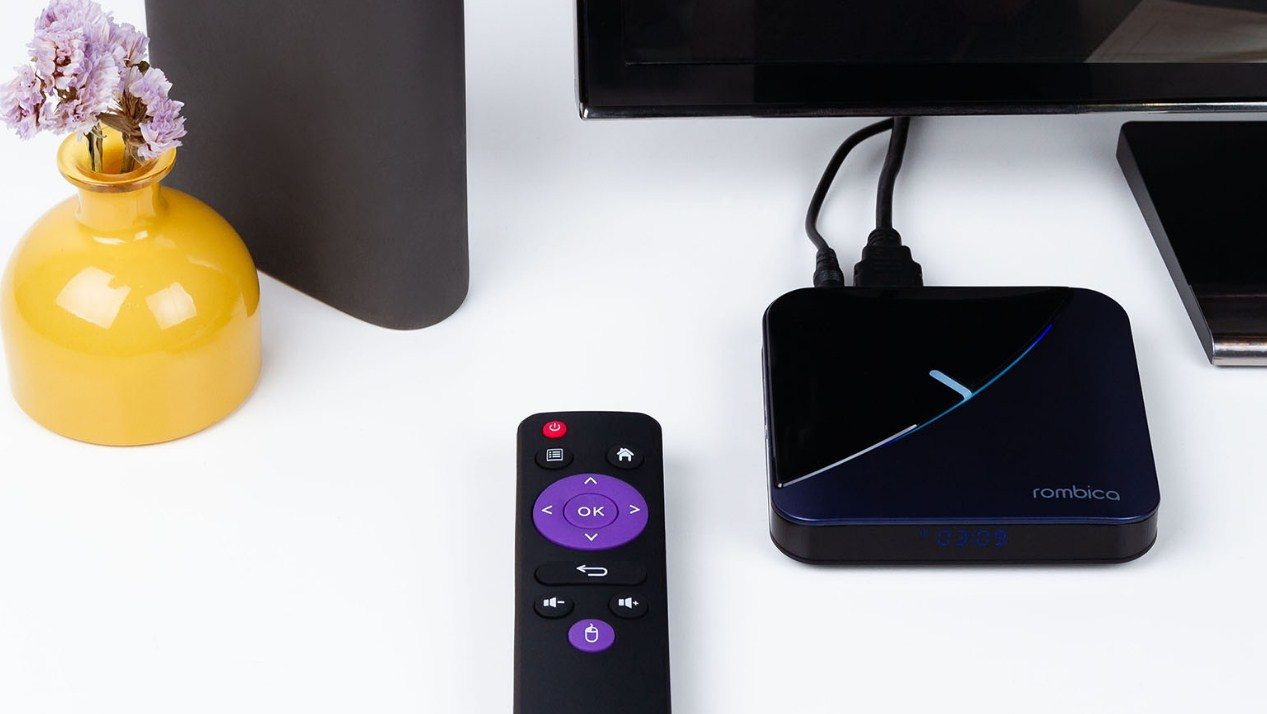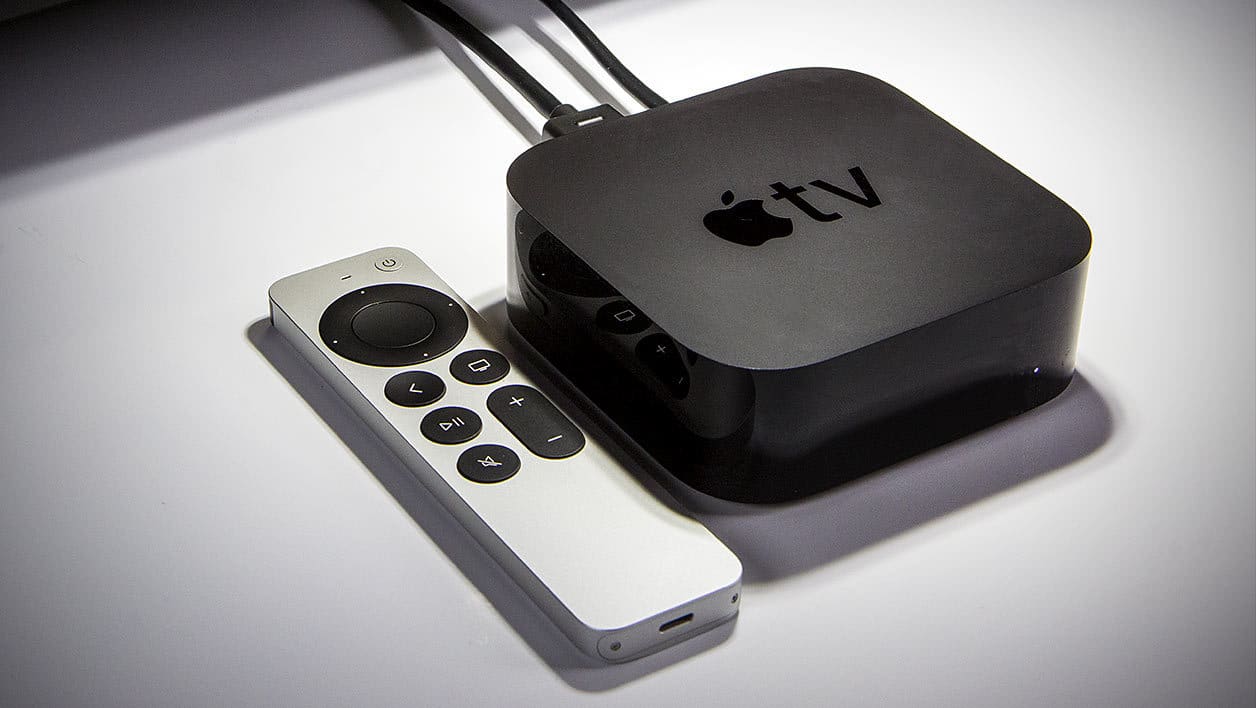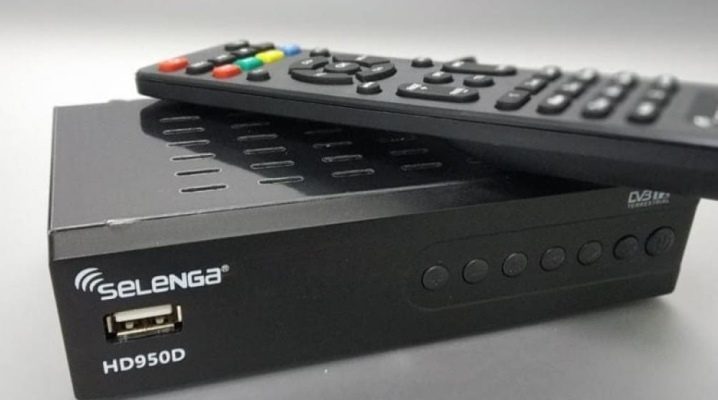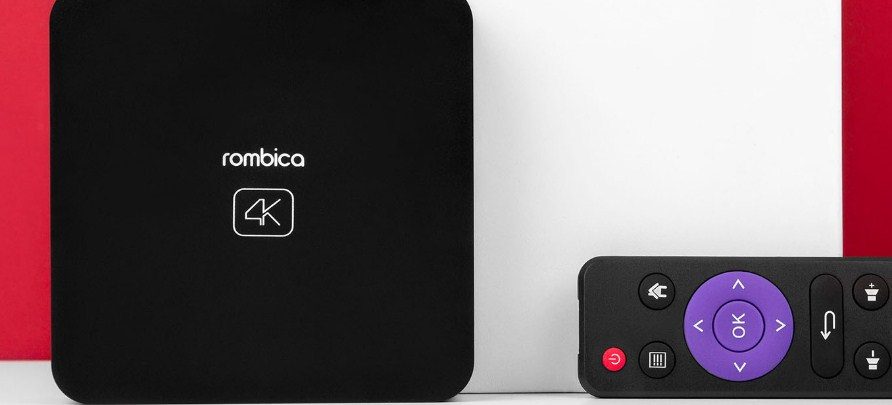In the 21st century, televisions have become so affordable for people that some families can easily afford to buy two or three devices at once in one apartment. But the question arises – how to competently transmit the signal simultaneously to all purchased devices. With the satellite provider Tricolor TV, there are several options for solving this problem. In this article, we will take a closer look at each of the methods and check what pitfalls a subscriber can expect in the process of setting up a connection.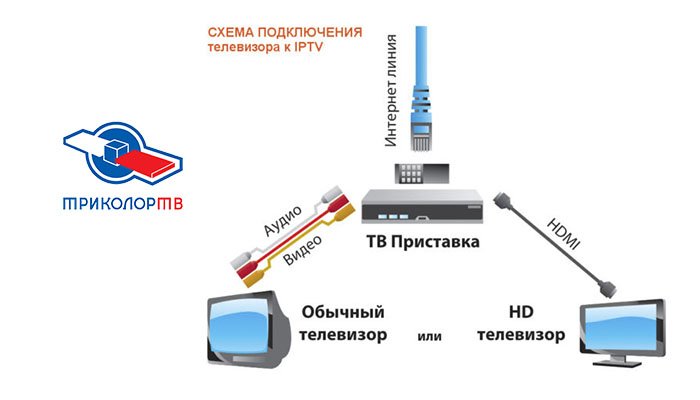 How to connect two TVs from one Tricolor receiver – new and old [/ caption]
How to connect two TVs from one Tricolor receiver – new and old [/ caption]
Broadcast options
There are two types of broadcast transmission to the user: mirror and separate. Mirroring means transferring the same image to other connected devices. This method does not require the use of additional equipment in the form of receivers for each of the TVs. But this method seriously strains viewers who do not have a tuner, since, in fact, it is the one who has the remote control that controls the viewing, and the rest are deprived of such an opportunity. About a separate type of transmission, its very name speaks. With this connection, an individual picture is broadcast for each separate device. Sounds good, but where is the difficulty? It lies in the fact that for this type of broadcasting, you need to buy additional equipment for each TV and somehow divide the incoming signal into several outgoing streams.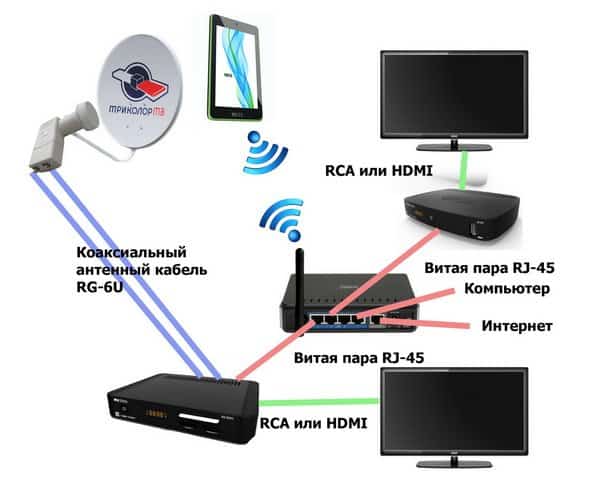 Two identical signals via wi fi and twisted pair allow you to connect Tricolor to two TVs from one receiver [/ caption]
Two identical signals via wi fi and twisted pair allow you to connect Tricolor to two TVs from one receiver [/ caption]
How to connect two TVs to one Tricolor TV receiver?
There are several ways to transmit the main signal from a satellite dish to auxiliary devices:
- using the output connector from the first receiving device;
- use a special splitter (divider) that splits the incoming signal into several streams;
- use converters with additional outputs.
You can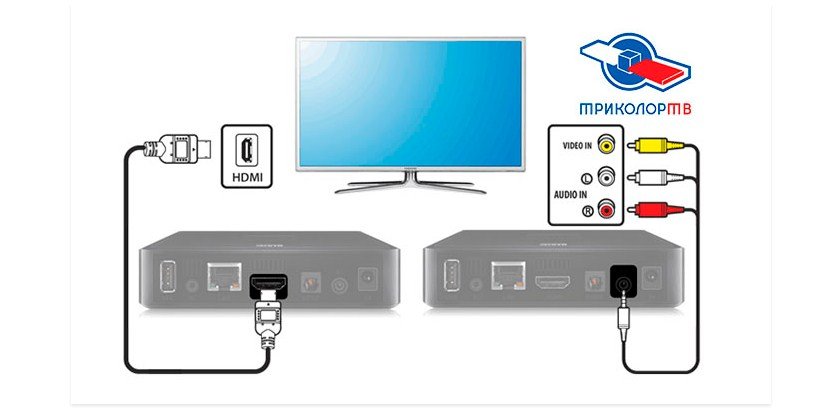 connect the tricolor to 2 TVs with one receiver using HDMI and AUX outputs [/ caption]
connect the tricolor to 2 TVs with one receiver using HDMI and AUX outputs [/ caption]
What additional equipment is needed?
The standard set of “Tricolor TV” does not provide for the presence of a converter and a divider, and therefore this equipment will have to be looked for and bought on your own. Here, too, there are subtleties. The principle of operation of the antenna converter for two outputs [/ caption]
The principle of operation of the antenna converter for two outputs [/ caption]
You should never choose a converter with a number of outlets “in reserve”, even if you ever plan to connect additional receivers in the future. The presence of empty slots on the converter will inevitably lead to loss of satellite signal.
Whichever type of connection is used, the signal quality will drop and this will be very noticeable. The best option would be to simply buy new equipment if you need to expand your home network. Let’s talk about a signal splitter, aka “splitter”. Above, we discussed converters that have multiple outputs. But what if you have a converter with one independent output, and you do not want to replace it with a new extended one? In this situation, the signal divider comes in handy. The signal divider allows you to send a signal to 2 TVs through 1 receiver [/ caption] Splitters, as well as converters, are for a different number of outputs. But it is worthwhile to understand that the more you divide the signal (into a large number of streams), the worse the reception on TVs will be. This is quite logical, since the signal from the converter output is designed by default to be received in one device. And the divider splits one such signal into two, four, eight devices … In addition, the length of the cable to the intended device also contributes. Even the best cables have a certain percentage of loss over distances. This is not the only disadvantage of dividing the signal in this way. The satellite signal has such a parameter as polarization. The channels are broadcast in two polarizations: horizontal and vertical. They use different voltages in their work, 13v and 18v,respectively. When using a splitter to divide the signal, the receiver loses the ability to switch this voltage. Simply put, simultaneous viewing of two different channels with different polarizations becomes technically impossible. A few years ago, this situation was not so critical, since almost all channels had the same polarization. But over time, more and more channels with a different polarization began to appear and the method of signal division becomes not so comfortable. But these options do not quite fit the topic of our question, since we are looking for an option with connecting a second TV without using an additional receiver. Perhaps the only option in this case is to connect the TV directly, through a cable coming out of the output port from the receiving tuner.When using a splitter to divide the signal, the receiver loses the ability to switch this voltage. Simply put, simultaneous viewing of two different channels with different polarizations becomes technically impossible. A few years ago, this situation was not so critical, since almost all channels had the same polarization. But over time, more and more channels with a different polarization began to appear and the method of signal division becomes not so comfortable. But these options do not quite fit the topic of our question, since we are looking for an option with connecting a second TV without using an additional receiver. Perhaps the only option in this case is to connect the TV directly, through a cable coming out of the output port from the receiving tuner.When using a splitter to divide the signal, the receiver loses the ability to switch this voltage. Simply put, the simultaneous viewing of two different channels with different polarization becomes technically impossible. A few years ago, this situation was not so critical, since almost all channels had the same polarization. But over time, more and more channels with a different polarization began to appear and the method of signal division becomes not so comfortable. But these options do not quite fit the topic of our question, since we are looking for an option with connecting a second TV without using an additional receiver. Perhaps the only option in this case is to connect the TV directly, through a cable coming out of the output port from the receiving tuner.Simply put, simultaneous viewing of two different channels with different polarizations becomes technically impossible. A few years ago, this situation was not so critical, since almost all channels had the same polarization. But over time, more and more channels with a different polarization began to appear and the method of signal division becomes not so comfortable. But these options do not quite fit the topic of our question, since we are looking for an option with connecting a second TV without using an additional receiver. Perhaps the only option in this case is to connect the TV directly through a cable coming out of the output port from the receiving tuner.Simply put, simultaneous viewing of two different channels with different polarizations becomes technically impossible. A few years ago, this situation was not so critical, since almost all channels had the same polarization. But over time, more and more channels with a different polarization began to appear and the method of signal division becomes not so comfortable. But these options do not quite fit the topic of our question, since we are looking for an option with connecting a second TV without using an additional receiver. Perhaps the only option in this case is to connect the TV directly, through a cable coming out of the output port from the receiving tuner.since almost all channels had the same polarization. But over time, more and more channels with a different polarization began to appear and the method of signal division becomes not so comfortable. But these options do not quite fit the topic of our question, since we are looking for an option with connecting a second TV without using an additional receiver. Perhaps the only option in this case is to connect the TV directly through a cable coming out of the output port from the receiving tuner.since almost all channels had the same polarization. But over time, more and more channels with a different polarization began to appear and the method of signal division becomes not so comfortable. But these options do not quite fit the topic of our question, since we are looking for an option with connecting a second TV without using an additional receiver. Perhaps the only option in this case is to connect the TV directly through a cable coming out of the output port from the receiving tuner.the only option in this case is to connect the TV directly, through a cable coming from the output port of the receiving tuner.the only option in this case is to connect the TV directly, through a cable coming from the output port of the receiving tuner.
The signal divider allows you to send a signal to 2 TVs through 1 receiver [/ caption] Splitters, as well as converters, are for a different number of outputs. But it is worthwhile to understand that the more you divide the signal (into a large number of streams), the worse the reception on TVs will be. This is quite logical, since the signal from the converter output is designed by default to be received in one device. And the divider splits one such signal into two, four, eight devices … In addition, the length of the cable to the intended device also contributes. Even the best cables have a certain percentage of loss over distances. This is not the only disadvantage of dividing the signal in this way. The satellite signal has such a parameter as polarization. The channels are broadcast in two polarizations: horizontal and vertical. They use different voltages in their work, 13v and 18v,respectively. When using a splitter to divide the signal, the receiver loses the ability to switch this voltage. Simply put, simultaneous viewing of two different channels with different polarizations becomes technically impossible. A few years ago, this situation was not so critical, since almost all channels had the same polarization. But over time, more and more channels with a different polarization began to appear and the method of signal division becomes not so comfortable. But these options do not quite fit the topic of our question, since we are looking for an option with connecting a second TV without using an additional receiver. Perhaps the only option in this case is to connect the TV directly, through a cable coming out of the output port from the receiving tuner.When using a splitter to divide the signal, the receiver loses the ability to switch this voltage. Simply put, simultaneous viewing of two different channels with different polarizations becomes technically impossible. A few years ago, this situation was not so critical, since almost all channels had the same polarization. But over time, more and more channels with a different polarization began to appear and the method of signal division becomes not so comfortable. But these options do not quite fit the topic of our question, since we are looking for an option with connecting a second TV without using an additional receiver. Perhaps the only option in this case is to connect the TV directly, through a cable coming out of the output port from the receiving tuner.When using a splitter to divide the signal, the receiver loses the ability to switch this voltage. Simply put, the simultaneous viewing of two different channels with different polarization becomes technically impossible. A few years ago, this situation was not so critical, since almost all channels had the same polarization. But over time, more and more channels with a different polarization began to appear and the method of signal division becomes not so comfortable. But these options do not quite fit the topic of our question, since we are looking for an option with connecting a second TV without using an additional receiver. Perhaps the only option in this case is to connect the TV directly, through a cable coming out of the output port from the receiving tuner.Simply put, simultaneous viewing of two different channels with different polarizations becomes technically impossible. A few years ago, this situation was not so critical, since almost all channels had the same polarization. But over time, more and more channels with a different polarization began to appear and the method of signal division becomes not so comfortable. But these options do not quite fit the topic of our question, since we are looking for an option with connecting a second TV without using an additional receiver. Perhaps the only option in this case is to connect the TV directly through a cable coming out of the output port from the receiving tuner.Simply put, simultaneous viewing of two different channels with different polarizations becomes technically impossible. A few years ago, this situation was not so critical, since almost all channels had the same polarization. But over time, more and more channels with a different polarization began to appear and the method of signal division becomes not so comfortable. But these options do not quite fit the topic of our question, since we are looking for an option with connecting a second TV without using an additional receiver. Perhaps the only option in this case is to connect the TV directly, through a cable coming out of the output port from the receiving tuner.since almost all channels had the same polarization. But over time, more and more channels with a different polarization began to appear and the method of signal division becomes not so comfortable. But these options do not quite fit the topic of our question, since we are looking for an option with connecting a second TV without using an additional receiver. Perhaps the only option in this case is to connect the TV directly through a cable coming out of the output port from the receiving tuner.since almost all channels had the same polarization. But over time, more and more channels with a different polarization began to appear and the method of signal division becomes not so comfortable. But these options do not quite fit the topic of our question, since we are looking for an option with connecting a second TV without using an additional receiver. Perhaps the only option in this case is to connect the TV directly through a cable coming out of the output port from the receiving tuner.the only option in this case is to connect the TV directly, through a cable coming from the output port of the receiving tuner.the only option in this case is to connect the TV directly, through a cable coming from the output port of the receiving tuner.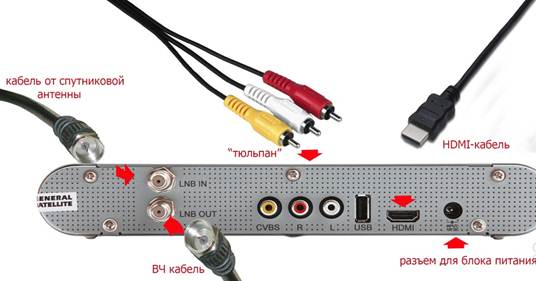 As you can see from the picture, the cable coming from the converter is connected to the receiver’s LNB IN jack, and the second cable comes out of the LNB OUT jack and goes to the second device with a built-in receiver. This is an easy-to-connect method, but for viewing on a second TV, the tuner must be always on. You won’t be able to watch different channels on both devices with this connection. Of all the options proposed, in the current realities, the most optimal is the use of converters with several slots, as well as additional receivers. All this will result in additional costs for the subscriber, but in this situation, each viewer will be able to watch what he wants and will not depend on the choice of the other. How to connect one Tricolor receiver to two or more TVs when using a second receiver – a detailed diagram:
As you can see from the picture, the cable coming from the converter is connected to the receiver’s LNB IN jack, and the second cable comes out of the LNB OUT jack and goes to the second device with a built-in receiver. This is an easy-to-connect method, but for viewing on a second TV, the tuner must be always on. You won’t be able to watch different channels on both devices with this connection. Of all the options proposed, in the current realities, the most optimal is the use of converters with several slots, as well as additional receivers. All this will result in additional costs for the subscriber, but in this situation, each viewer will be able to watch what he wants and will not depend on the choice of the other. How to connect one Tricolor receiver to two or more TVs when using a second receiver – a detailed diagram: Tricolor TV for 2 TVs: set, diagram and connection process without a second receiver [/ caption]
Tricolor TV for 2 TVs: set, diagram and connection process without a second receiver [/ caption]
What are the diagrams for connecting two TVs to two Tricolor TV receivers?
The figure above clearly shows a diagram of connecting two TVs through two separate tuners, receiving a signal from one output of the converter and then dividing it into two streams using a splitter. This method is not the most expensive in its implementation, but also not the most effective. The costs go to an additional receiver, which, by the way, does not have to be new (you can purchase a markdown) and a regular divider. What problems can arise?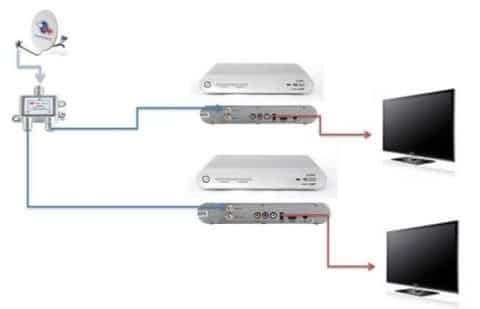 Two TVs for two Tricolor receivers [/ caption] A little earlier they have already been described, these are problems with polarization. Of course, in most cases, users will be able to watch different channels as if nothing had happened. However, if they start watching channels with different polarizations, then one of them will simply have a black screen instead of broadcasting. You can also consider this connection option:
Two TVs for two Tricolor receivers [/ caption] A little earlier they have already been described, these are problems with polarization. Of course, in most cases, users will be able to watch different channels as if nothing had happened. However, if they start watching channels with different polarizations, then one of them will simply have a black screen instead of broadcasting. You can also consider this connection option: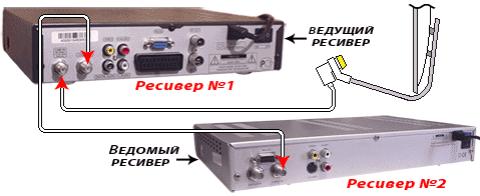 It is somewhat reminiscent of the case that we considered when connecting two TVs to one tuner. Here, in the same way, the cable from the converter enters the jack to the master receiver, and that, in turn, “gives” the outgoing signal to the slave receiver. The second TV is already connected to the latter and receives an image. It seems to be two different schemes, but its disadvantages are exactly the same. The output signal is still in a single variant and is divided by the already master receiver. Therefore, problems with polarization do not go anywhere.
It is somewhat reminiscent of the case that we considered when connecting two TVs to one tuner. Here, in the same way, the cable from the converter enters the jack to the master receiver, and that, in turn, “gives” the outgoing signal to the slave receiver. The second TV is already connected to the latter and receives an image. It seems to be two different schemes, but its disadvantages are exactly the same. The output signal is still in a single variant and is divided by the already master receiver. Therefore, problems with polarization do not go anywhere. Now we come to the most expensive and comfortable connection option. As can be seen from the figure, this circuit already uses more than one output signal from the converter. A converter for two outputs is not the cheapest pleasure, it will obviously cost more than buying a simple signal divider. But these costs have their advantages. Two equivalent independent signals come to two inputs of the master set-top box. In this case, the second tuner, which is shown in the picture, does not have its own receiver. All reception is done through the master tuner. Why is this done? To reduce the cost of a second receiver. You save extra “pretty penny” that you can spend on the same 2-output converter. The tuners are connected to each other with a usual and familiar to everyone Ethernet cable. What is the convenience of this scheme? And they are obvious. Since there are two incoming signals from the converter,then each broadcast receiver becomes independent of each other. Channels with different polarization are no longer problematic, they can be safely watched simultaneously on two TVs. How to connect 2 TVs to one receiver, including the Tricolor set-top boxes: https://youtu.be/Zbx-4rkGePw
Now we come to the most expensive and comfortable connection option. As can be seen from the figure, this circuit already uses more than one output signal from the converter. A converter for two outputs is not the cheapest pleasure, it will obviously cost more than buying a simple signal divider. But these costs have their advantages. Two equivalent independent signals come to two inputs of the master set-top box. In this case, the second tuner, which is shown in the picture, does not have its own receiver. All reception is done through the master tuner. Why is this done? To reduce the cost of a second receiver. You save extra “pretty penny” that you can spend on the same 2-output converter. The tuners are connected to each other with a usual and familiar to everyone Ethernet cable. What is the convenience of this scheme? And they are obvious. Since there are two incoming signals from the converter,then each broadcast receiver becomes independent of each other. Channels with different polarization are no longer problematic, they can be safely watched simultaneously on two TVs. How to connect 2 TVs to one receiver, including the Tricolor set-top boxes: https://youtu.be/Zbx-4rkGePw
Tricolor TV set for 2 TVs
For such cases, the official operator has already created a technical solution that allows you to watch TV channels on two TVs with only one contract. Tricolor TV has such a service called “Multiroom”. More about its tariffs:
- “United Mult Light” – the client is provided with access to the basic line of channels for viewing on two receivers.
- “Unified Mult” – packages that are additionally connected by users are added to the basic line of TV channels. Without purchasing this package, subscribers will be given access only to a standard set of channels.
The connection cost differs depending on the region where the service is provided.
Outcomes
In this article, we have raised interesting and difficult questions with connecting multiple devices to satellite TV. Various options are possible, both with the connection of two TVs through one set-top box, and through two set-top boxes. At the same time, perhaps only one connection method does not carry any flaws for the subscriber, but also “hits” the wallet. Ultimately, each option has the right to life and the final decision is made by the subscriber himself, relying on his tastes and financial capabilities.


